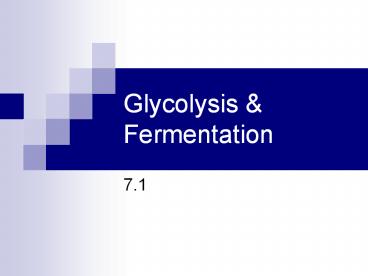Glycolysis & Fermentation PowerPoint PPT Presentation
1 / 47
Title: Glycolysis & Fermentation
1
Glycolysis Fermentation
- 7.1
2
ATP is the main energy currency of cells
- Cellular respiration process of making ATP by
breaking down organic compounds - A catabolic, exergonic, oxygen (O2) requiring
process that uses energy extracted from
macromolecules (glucose) to produce energy (ATP)
and water (H2O).
3
Cellular respiration equation
- C6H12O6 6O2 ? 6CO2 6H2O energy
byproduct
4
- Who uses cellular respiration and
- Where does it take place?
5
Who undergoes cellular respiration? (eukaryotes)
- Plants - Autotrophs self-producers.
- Animals - Heterotrophs consumers.
6
What are the Stages of Cellular Respiration?
- Glycolysis
- The Krebs Cycle
- The Electron Transport Chain
7
Where? Mitochondria
- Organelle where cellular respiration takes place.
8
Redox Reaction
- Transfer of one or more electrons from one
reactant to another. - Two types
- 1. Oxidation
- 2. Reduction
9
Oxidation Reaction
- The loss of electrons from a substance.
- Or the gain of oxygen.
- C6H12O6 6O2 ?6CO2 6H2O energy
10
Reduction Reaction
- The gain of electrons to a substance.
- Or the loss of oxygen.
byproduct
11
Breakdown of Cellular Respiration
- 1. Glycolysis (splitting of sugar)
- a. cytosol, just outside of mitochondria.
- 2. Grooming Phase
- a. migration from cytosol to matrix.
12
Breakdown of Cellular Respiration
- 3. Krebs Cycle (Citric Acid Cycle)
- a. mitochondrial matrix
- 4. Electron Transport Chain (ETC) and
- Oxidative Phosphorylation
- a. Also called Chemiosmosis
- b. inner mitochondrial membrane.
13
GLYCOLYSIS
- biochemical pathway, yields 2 ATP
- Occurs in cytosol
- Converts NAD oxidized to NADH to produce pyruvic
acid then reduced to form lactic acid - With Oxygen gt aerobic - additional ATP
- Without Oxygen gt anaerobic - fermentation yields
NO additional ATP
14
1. Glycolysis
- A. Energy use Phase
15
1. Glycolysis
- B. Energy Yielding Phase
16
1. Glycolysis
- Total Net Yield
- 2 - 3C-Pyruvate (PYR)
- 2 - ATP (Substrate-level Phosphorylation)
- 2 - NADH
17
Substrate-Level Phosphorylation
- ATP is formed when an enzyme transfers a
phosphate group from a substrate to ADP.
Example PEP to PYR
18
Animation
- http//www.science.smith.edu/departments/Biology/B
io231/glycolysis.html
19
RECALL
- Redox one reactant is oxidized while another is
reduced - oxidized loses e- and becomes pos
- reduced gains e- and becomes neg
20
GYLCOLYSIS RECAP
- glucose oxidized yields pyruvic acid
- reactions take place in cytosol
- NAD to NADH (electron acceptor)
- Pyruvic acid yields 4 ATP but 2 used in process
(so net yield is 2 ATP)
21
Fermentation
- fermentation is the formation of alcohol from
sugar. - Occurs in cytosol when NO Oxygen is present
(called anaerobic). - Remember glycolysis is part of fermentation.
- Two Types
- 1. Lactic Acid (animal cells)
- 2. Alcohol (plant cells)
22
Lactic acid fermentation
- NADH oxidized to NAD
- e.g. Yogurt, cheese
- in muscle not enough oxygen so switch to
anaerobic respiration b/c oxygen is depleted
which makes cytosol acidic so produces cramps
23
Lactic Acid Fermentation
- Animals (pain in muscle after a workout).
24
Lactic Acid Fermentation
- End Products Lactic acid fermentation
- 2 - ATP (phosphorylation)
- 2 - Lactic Acids
25
Alcoholic Fermentation
- convert pyruvic to ethyl alcohol by removing CO2
- e.g. bread, beer, wine - need enzymes in yeast
26
Alcohol Fermentation
- Plants and Fungi ? beer and wine
27
Alcohol Fermentation
- End Products
- 2 - ATP (phosphorylation)
- 2 - CO2
- 2 - Ethanols
28
- glycolysis is not efficient but unicellular
organisms dont need much energy to function - E.g. paramecium, ameoba
- probably evolved early in history of life
29
- kilocalories 1 kcal 1000 cal
30
How does the overall equation for aerobic
respiration relate to its four stages?
- http//w3.dwm.ks.edu.tw/bio/activelearner/07/ch7in
tro.html
31
Aerobic Respiration
- 7.2
32
Aerobic respiration
- cellular respiration that requires oxygen
- 2 major stages Krebs cycle electron transport
chain
33
STAGE 1
- Krebs cycle biochemical pathway that breaks
down acetyl CoA producing CO2, Hydrogen, ATP - Aka Citric Acid Cycle
- Completes oxidation of glucose began in
glycolysis - Takes place in/ mitochondrion unlike glycolysis
that occurs in/ cytosol
34
- Pyruvic acid from glycolysis diffuses across
membrane to Mitochondrial matrix forms Acetyl
coenzyme A (acetyl CoA)
35
(No Transcript)
36
(No Transcript)
37
5 Steps in Krebs cycle
- Step 1 produces citric acid
- Step 2 releases CO2
- Step 3 releases CO2
- Step 4 conversion of 4-carbon compound
- Step 5 4-carbon compound converted back to
oxaloacetic acid
38
(No Transcript)
39
- Citric acid - formed when acetyl CoA combines
with Oxaloacetic acid - FAD - flavin adenine dinucleotide like NAD b/c
accepts electrons
40
- Each turn of citric acid cycle produces
- ATP, NADH, FADH2
41
- In glycolysis 1 glucose produced 2 ATP which is
same as Krebs cycle
42
Stage 2
- Electron transport chain occurs along inner
membrane - Concentration gradient between 2 membranes drive
chain - ATP synthase catalyzes ATP from ADP and phosphate
ion known as chemiosmosis just like photosynthesis
43
(No Transcript)
44
(No Transcript)
45
Efficiency of energy
- glycolysis 2 ATP
- Krebs 2 ATP
- E.T.C. 34 ATP
- 38 ATP
- but some is used to pump NADH across membrane so
36 ATP
46
summary of Cellular Respiration
http//www.estrellamountain.edu/faculty/farabee/bi
obk/BioBookGlyc.html
47
References
- http//www.search.com/reference/Mitochondrion
- http//images.google.com/imgres?imgurlhttp//micr
obewiki.kenyon.edu/images/thumb/2/25/Mitochondria.
gif/400px-Mitochondria.gifimgrefurlhttp//microb
ewiki.kenyon.edu/index.php/Mitochondriah311w40
0sz94hlenstart107um1tbnid7oaJZwsF_GSTgM
tbnh96tbnw124prev/images3Fq3Dmitochondrial
2Bmatrix26start3D10026ndsp3D2026svnum3D102
6um3D126hl3Den26rlz3D1T4GGIC_enUS233US23326s
a3DN - http//images.google.com/imgres?imgurlhttp//wps.
prenhall.com/wps/media/objects/486/498525/FG06_12F
R.JPGimgrefurlhttp//wps.prenhall.com/esm_freema
n_biosci_1/0,6452,498573-,00.htmlh268w550sz4
1hlenstart17um1tbnidOG0HGNN3_pgRmMtbnh6
5tbnw133prev/images3Fq3Dmitochondrial2Bmatr
ix26svnum3D1026um3D126hl3Den26rlz3D1T4GGIC
_enUS233US23326sa3DG - http//www.estrellamountain.edu/faculty/farabee/bi
obk/BioBookGlyc.html - www.biologyjunction.com

